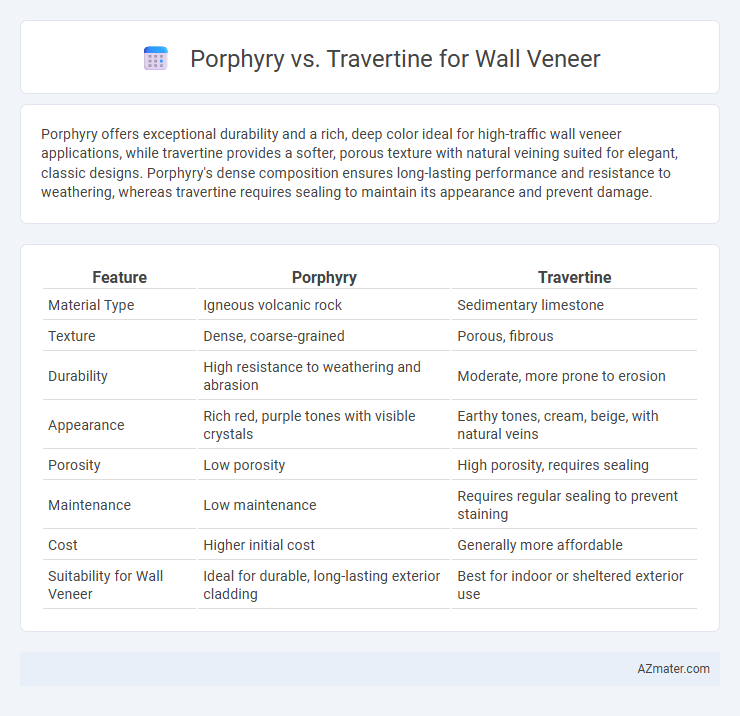Porphyry offers exceptional durability and a rich, deep color ideal for high-traffic wall veneer applications, while travertine provides a softer, porous texture with natural veining suited for elegant, classic designs. Porphyry's dense composition ensures long-lasting performance and resistance to weathering, whereas travertine requires sealing to maintain its appearance and prevent damage.
Table of Comparison
| Feature | Porphyry | Travertine |
|---|---|---|
| Material Type | Igneous volcanic rock | Sedimentary limestone |
| Texture | Dense, coarse-grained | Porous, fibrous |
| Durability | High resistance to weathering and abrasion | Moderate, more prone to erosion |
| Appearance | Rich red, purple tones with visible crystals | Earthy tones, cream, beige, with natural veins |
| Porosity | Low porosity | High porosity, requires sealing |
| Maintenance | Low maintenance | Requires regular sealing to prevent staining |
| Cost | Higher initial cost | Generally more affordable |
| Suitability for Wall Veneer | Ideal for durable, long-lasting exterior cladding | Best for indoor or sheltered exterior use |
Introduction to Porphyry and Travertine Wall Veneers
Porphyry wall veneers feature a dense, igneous rock with a distinctive coarse-grained texture and rich red, purple, or gray hues, offering exceptional durability and resistance to weathering. Travertine wall veneers, formed from sedimentary limestone, showcase a natural, porous surface with warm earth tones including beige, cream, and rust, providing a classic, elegant appearance ideal for both interior and exterior applications. Both materials offer unique aesthetic and structural properties, making them popular choices in architectural design for creating textured, visually appealing wall surfaces.
Understanding Porphyry: Properties and Origins
Porphyry is an igneous rock characterized by large, well-formed crystals embedded in a fine-grained matrix, originating from volcanic activity. Its durability, resistance to weathering, and unique texture make porphyry an excellent choice for wall veneer applications. Unlike travertine, which is sedimentary and formed from mineral springs, porphyry's mineral composition and volcanic origin contribute to its high strength and long-lasting aesthetic appeal.
Travertine Explained: Characteristics and Formation
Travertine is a sedimentary rock formed through the rapid precipitation of calcium carbonate from mineral-rich hot springs or limestone caves, resulting in distinctive porous textures and layered patterns. Its natural earthy tones, ranging from creamy whites to warm beiges and browns, complement interior and exterior wall veneers with a timeless aesthetic. Compared to the coarse-grained, igneous texture of porphyry, travertine offers a softer, more porous surface that enhances breathability and adds a classic Mediterranean appeal to architectural walls.
Aesthetic Differences: Color and Texture Comparison
Porphyry wall veneer features a rich, deep red to purple coloration with scattered feldspar crystals creating a distinctive speckled texture, offering a bold and dramatic aesthetic. Travertine, in contrast, showcases creamy beige to warm earth tones with natural pitted textures and banded patterns, lending a softer, more rustic appearance. The choice between porphyry's vibrant, crystalline surface and travertine's porous, layered look significantly impacts interior or exterior design styles.
Durability and Longevity: Porphyry vs Travertine
Porphyry exhibits superior durability and longevity compared to travertine due to its dense, igneous composition, making it highly resistant to weathering, abrasion, and chemical exposure. Travertine, a sedimentary rock, is more porous and susceptible to etching and staining, which can reduce its lifespan when used as wall veneer in exterior applications. For long-term performance, porphyry's hardness and low porosity ensure better structural integrity and resistance to environmental damage over decades.
Installation Process: Which is Easier for Wall Veneer?
Travertine wall veneer offers a simpler installation process due to its lightweight nature and consistent texture, which allows for easier cutting and shaping compared to Porphyry. Porphyry requires specialized tools and experienced handling because of its hardness and density, making installation more labor-intensive and time-consuming. For DIY projects or quicker setups, Travertine is the preferred choice, while Porphyry suits professional installations seeking durability and distinct aesthetics.
Maintenance Requirements: Cleaning and Care Tips
Porphyry wall veneers require minimal maintenance due to their dense, hard surface that resists staining and weathering, making regular dusting and occasional washing with mild detergent sufficient. Travertine wall veneers need more careful upkeep, including sealing every 1-2 years to prevent moisture absorption and using pH-neutral cleaners to avoid etching or discoloration. Both materials benefit from prompt spill cleanup and avoiding abrasive tools to preserve their natural finish and longevity.
Cost Analysis: Porphyry vs Travertine Wall Veneer
Porphyry wall veneer typically has a higher upfront cost due to its durability and unique aesthetic appeal, making it a long-term investment for exterior and interior applications. Travertine veneer is generally more affordable initially but may require more maintenance over time, potentially increasing overall expenses. Factoring in installation complexity and material longevity, Porphyry often offers better cost-efficiency despite the premium price compared to Travertine for wall cladding projects.
Best Applications: Where Each Stone Excels
Porphyry, known for its hardness and rich reddish tones, excels in exterior wall veneers exposed to harsh weather and heavy foot traffic due to its durability and low porosity. Travertine, with its porous texture and warm, neutral colors, is ideal for interior wall veneers, especially in bathrooms and living spaces where a natural, elegant aesthetic is desired. Both stones offer unique benefits, with porphyry suited for long-lasting, rugged applications and travertine perfect for decorative, moisture-resistant environments.
Sustainability and Environmental Impact
Porphyry's durability and low porosity make it a sustainable option for wall veneer, minimizing maintenance and extending lifespan, which reduces material waste over time. Travertine, while natural and biodegradable, requires more frequent sealing and maintenance due to its higher porosity, potentially increasing environmental impact through additional chemical use. Both stones are natural materials, but porphyry's extraction and transportation demand careful consideration to balance sustainability benefits against carbon footprint.

Infographic: Porphyry vs Travertine for Wall Veneer
 azmater.com
azmater.com